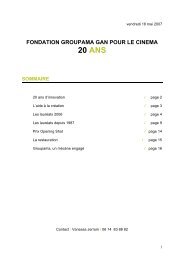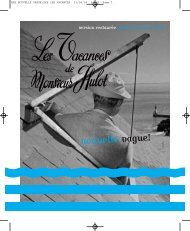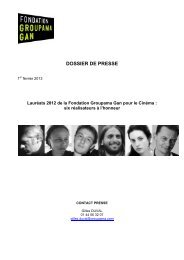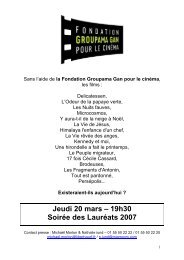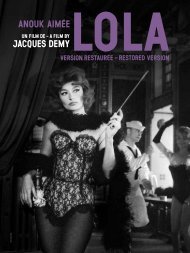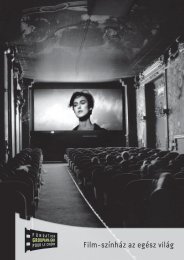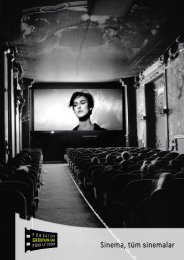duVoyage - Fondation Groupama Gan pour le Cinéma
duVoyage - Fondation Groupama Gan pour le Cinéma
duVoyage - Fondation Groupama Gan pour le Cinéma
You also want an ePaper? Increase the reach of your titles
YUMPU automatically turns print PDFs into web optimized ePapers that Google loves.
Georges Meliès<br />
1899<br />
He makes a politically-oriented<br />
film about the Dreyfus Affair<br />
using ‘reconstructions<br />
of actual events’. He plays the<br />
ro<strong>le</strong> of Labori, one of Captain<br />
Dreyfus’ lawyers.<br />
1902<br />
The film ‘A Trip to the Moon’<br />
achieves worldwide success<br />
and is widely copied in the<br />
USA. Georges Méliès sends his<br />
brother Gaston over there to<br />
protect his interests and establish<br />
his business on the<br />
American market.<br />
1902<br />
France/Creation of the first<br />
Pathé studio in Montreuil,<br />
followed by two others, in<br />
Vincennes and Montreuil. .<br />
1904<br />
Georges Méliès founds the<br />
magicians’ trade association,<br />
of which he remains the<br />
chairman until the end of his<br />
life.<br />
1904<br />
Pathé-Frères grows, opening a<br />
subsidiary in New York.<br />
1905-1906<br />
Invention of film coloring<br />
stencils (to replace the workshops<br />
where films were handpainted<br />
using a brush). Pathé<br />
develops a mechanical stencil<br />
coloring process.<br />
1905<br />
Popular ‘Nickelodeon’ theaters<br />
spring up in America, with<br />
programs changing daily.<br />
1908<br />
After his admission in 1907 to<br />
the first cartel formed by<br />
Edison to control American<br />
production, which becomes an<br />
industry, he is forced to increase<br />
his production rate<br />
and therefore builds Studio B<br />
so that he can shoot two movies<br />
in paral<strong>le</strong>l.<br />
Birth of motion picture<br />
1908<br />
End of the ‘Patent Wars’ in<br />
which Edison took <strong>le</strong>gal action<br />
against all competitors in the<br />
USA, resulting in the creation<br />
of a trust: the Motion Picture<br />
Patents Company.<br />
98<br />
1909<br />
He chairs the international<br />
conference of film editors<br />
in Paris.<br />
1912<br />
He makes his last film, ‘The<br />
Bourrichon family’s journey’.<br />
From 1896 to 1912, he makes<br />
520 films, of which he is the<br />
producer, distributor, writer,<br />
set designer, director, and <strong>le</strong>ading<br />
actor. His latter films are<br />
not as successful as he hoped<br />
because of competition from<br />
young filmmakers and their<br />
modern ideas. He did not<br />
create a company at any stage;<br />
he always invested his own<br />
money, and his finances end<br />
up in a critical situation.<br />
1909<br />
International conference of<br />
film producers, chaired by<br />
Georges Méliès. The Edison<br />
perforation is adopted as the<br />
standard. Motion pictures are<br />
no longer sold, but rented.<br />
1913<br />
His wife dies and he closes<br />
down both studios for good.<br />
The showing of his movies in<br />
the USA and the movies made<br />
by his brother Gaston provide<br />
him with some income when<br />
the Robert-Houdin theater<br />
(like every other theater)<br />
closes in 1914 because of the<br />
First World War.<br />
1917-1922<br />
He converts Studio B to a variety<br />
theater, directed by his<br />
daughter Georgette. He ends<br />
up playing over a hundred<br />
different ro<strong>le</strong>s there, alongside<br />
his son and daughter and<br />
other actors and opera singers.<br />
1923<br />
Georges Méliès is bankrupt.<br />
He sells his Montreuil property<br />
to pay his debts. The<br />
same year, the Robert-Houdin<br />
theater, which he had directed<br />
continuously until the<br />
outbreak of the First World<br />
War, is expropriated and demolished<br />
for the extension of<br />
Bou<strong>le</strong>vard Haussmann.<br />
1925<br />
Georges Méliès marries Jehanne<br />
d’Alcy (the widow Manieux),<br />
one of his former performers<br />
at the Robert-Houdin<br />
theater and then a movie actress.<br />
She currently runs a<br />
store selling toys and candy in<br />
the concourse of Montparnasse<br />
Station.<br />
1929<br />
Georges Méliès is honored at<br />
a gala event held at the P<strong>le</strong>yel<br />
hall, Paris, in December.<br />
1931<br />
Louis Lumière presents him<br />
with the Cross of the Legion of<br />
Honor.<br />
1932<br />
France is experiencing a serious<br />
economic crisis, and the<br />
toy store is not making a profit.<br />
Georges Méliès, his wife,<br />
and his granddaughter Made<strong>le</strong>ine<br />
are invited to live at<br />
Orly cast<strong>le</strong>, which belongs to<br />
the Mutuel<strong>le</strong> du <strong>Cinéma</strong>.<br />
1938<br />
Georges Méliès dies in Paris<br />
on January 21 st .<br />
Much earlier…<br />
The physiological effect of retinal persistence was observed by Isaac Newton and<br />
Patrick (<strong>le</strong> Chevalier) d’Arcy and in the 17 th and 18 th centuries. This defect of the eye,<br />
combined with the brain’s ability to interconnect several separate images, makes it<br />
possib<strong>le</strong> to create simulated motion. The first scientific demonstration of this effect is<br />
the Faraday wheel in 1830, followed by other devices, such as the Thaumatrope, the Phenakistiscope,<br />
the Zootrope, the Praxinoscope, etc. These were quite commonly marketed<br />
as toys from 1850 onward. Austrian general Franz von Uchatius enhanced the technique<br />
with a projection system in 1853, inspired by magic lanterns, an ancestor of the<br />
projector, in existence since the 17 th century. The birth of photography took place in 1839<br />
thanks to Jacques Daguerre. The next step was to combine these devices that recreate<br />
motion with the concept of photography.<br />
99






